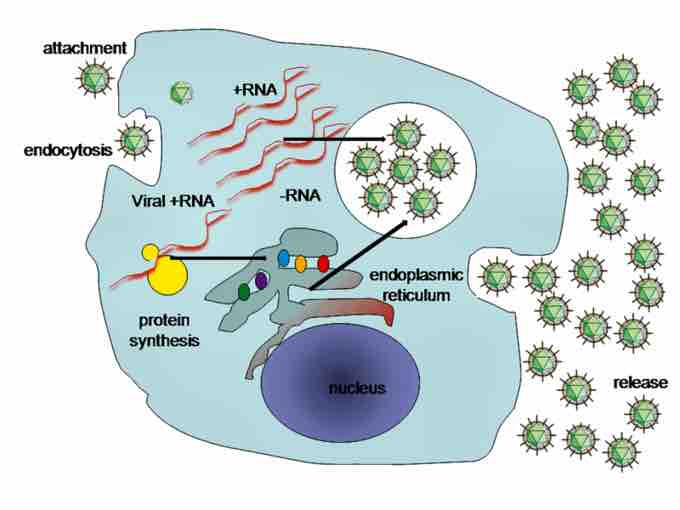Multiplication Within the Host Cell
Viral replication is the term used indicate the formation of biological viruses during the infection process in the target host cells. Viruses must first penetrate and enter the cell before viral replication can occur. From the perspective of the virus, the purpose of viral replication is to allow reproduction and survival of its kind. By generating abundant copies of its genome and packaging these copies into viruses, the virus is able to continue infecting new hosts.
Replication between viruses is varied and depends on the type of genes involved. Most DNA viruses assemble in the nucleus; most RNA viruses develop solely in cytoplasm. Viral populations do not grow through cell division, because they are acellular. Instead, they hijack the machinery and metabolism of a host cell to produce multiple copies of themselves, and they assemble inside the cell.
The life cycle of viruses differs greatly between species but there are six common basic stages:
Attachment is a specific binding between viral capsid proteins and specific receptors on the host cellular surface. This specificity determines the host range of a virus. For example, HIV can infect only a limited range of human leukocytes. Its surface protein, gp120, specifically interacts only with the CD4 molecule – a chemokine receptor – which is most commonly found on the surface of CD4+ T-Cells. This mechanism has evolved to favor those viruses that infect only cells within which they are capable of replication. Attachment to the receptor can fore the viral envelope protein to undergo either changes that result in the fusion of viral and cellular membranes, or changes of non-enveloped virus surface proteins that allow the virus to enter.
Penetration follows attachment. Virions enter the host cell through receptor-mediated endocytosis or membrane fusion. This is often called viral entry. The infection of plant and fungal cells is different from that of animal cells. Plants have a rigid cell wall made of cellulose, and fungi one of chitin, so most viruses can get inside these cells only after trauma to the cell wall. However, nearly all plant viruses (such as tobacco mosaic virus) can also move directly from cell to cell, in the form of single-stranded nucleoprotein complexes, through pores called plasmodesmata. Bacteria, like plants, have strong cell walls that a virus must breach to infect the cell. However, since bacterial cell walls are much less thick than plant cell walls due to their much smaller size, some viruses have evolved mechanisms that inject their genome into the bacterial cell across the cell wall, while the viral capsid remains outside.
Uncoating is a process in which the viral capsid is removed: This may be by degradation by viral or host enzymes or by simple dissociation. In either case the end-result is the release of the viral genomic nucleic acid.
Replication of viruses depends on the multiplication of the genome. This is accomplished through synthesis of viral messenger RNA (mRNA) from "early" genes (with exceptions for positive sense RNA viruses), viral protein synthesis, possible assembly of viral proteins, then viral genome replication mediated by early or regulatory protein expression. This may be followed, for complex viruses with larger genomes, by one or more further rounds of mRNA synthesis: "late" gene expression is, in general, of structural or virion proteins.
Following the structure-mediated self-assembly of the virus particles, some modification of the proteins often occurs. In viruses such as HIV, this modification (sometimes called maturation) occurs after the virus has been released from the host cell.
Viruses can be released from the host cell by lysis, a process that kills the cell by bursting its membrane and cell wall if present. This is a feature of many bacterial and some animal viruses. Some viruses undergo a lysogenic cycle where the viral genome is incorporated by genetic recombination into a specific place in the host's chromosome. The viral genome is then known as a provirus or, in the case of bacteriophages a prophage. Whenever the host divides, the viral genome is also replicated. The viral genome is mostly silent within the host; however, at some point the provirus or prophage may give rise to active virus, which may lyse the host cells. Enveloped viruses (e.g., HIV) typically are released from the host cell by budding. During this process the virus acquires its envelope, which is a modified piece of the host's plasma or other internal membrane. The genetic material within virus particles, and the method by which the material is replicated, varies considerably between different types of viruses.

Hepatitis C virus
A simplified diagram of the Hepatitis C virus replication cycle.